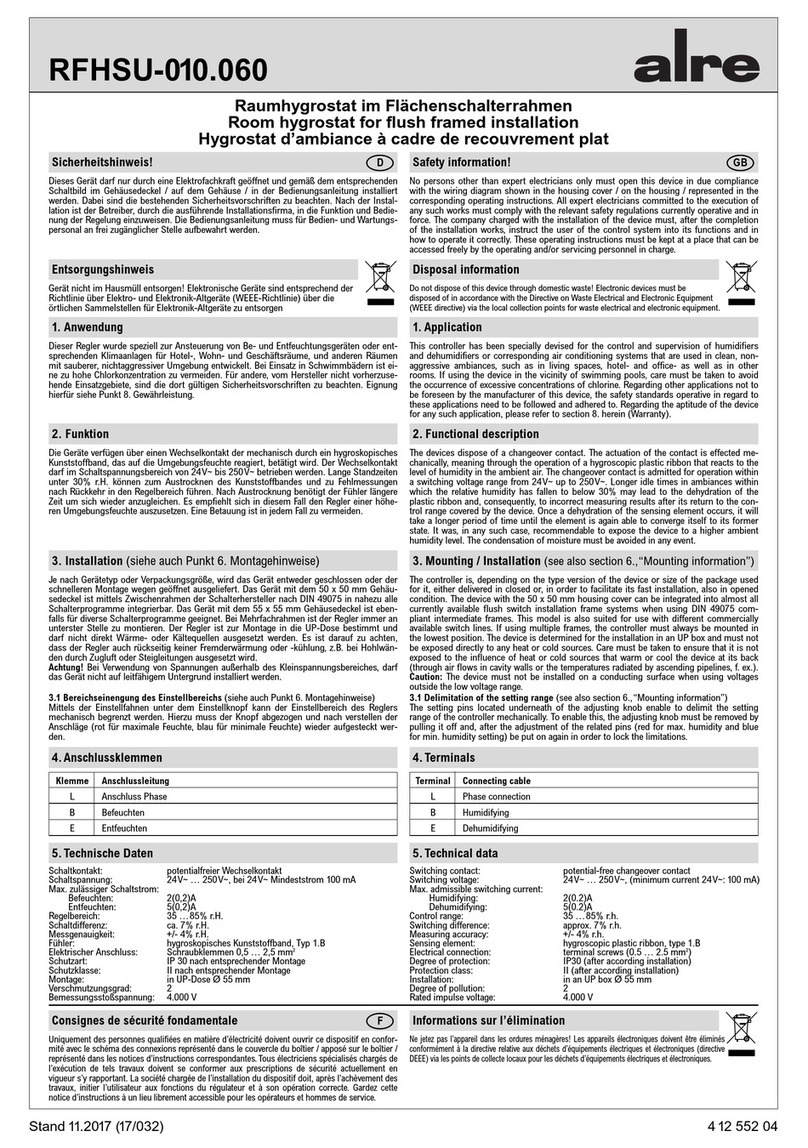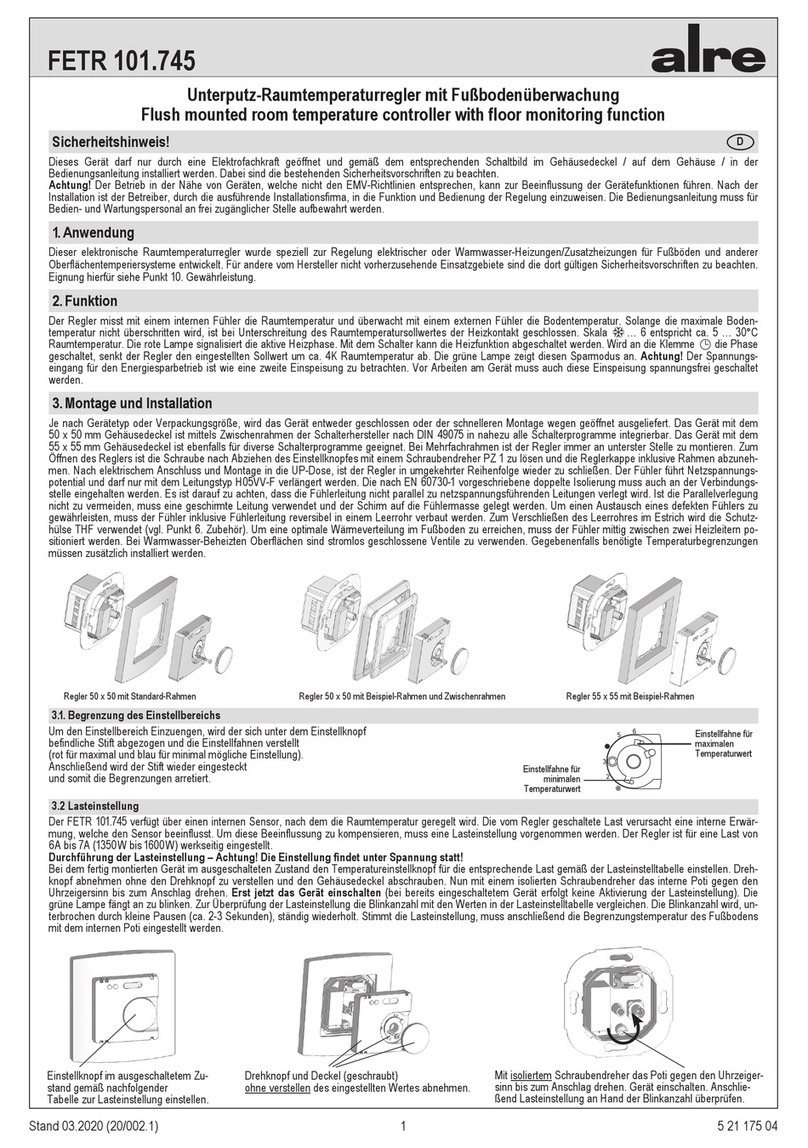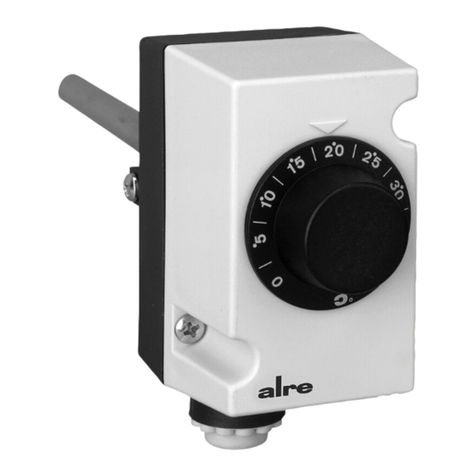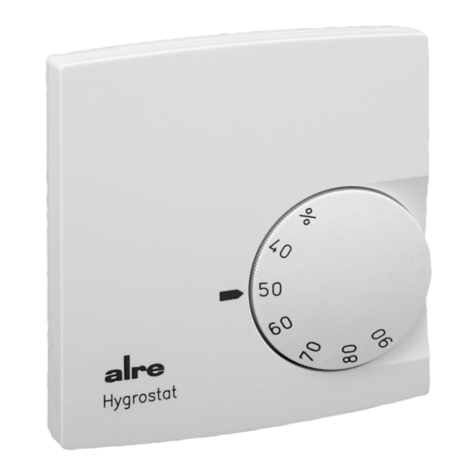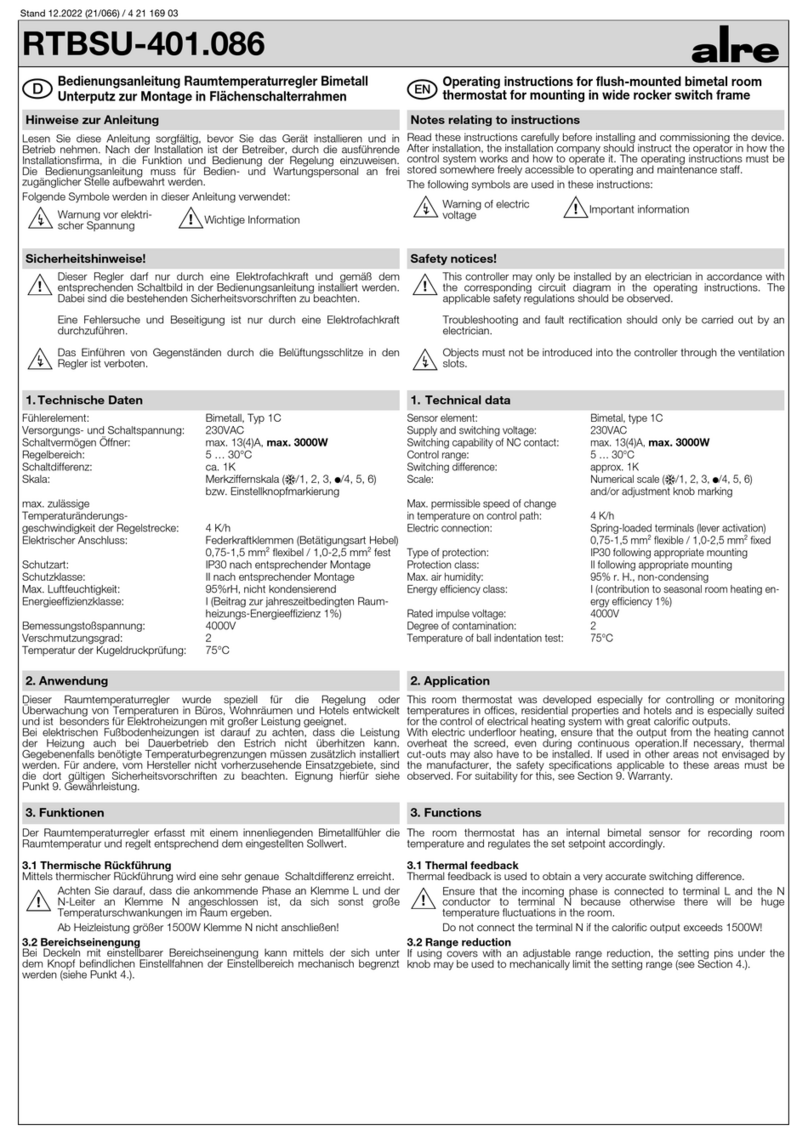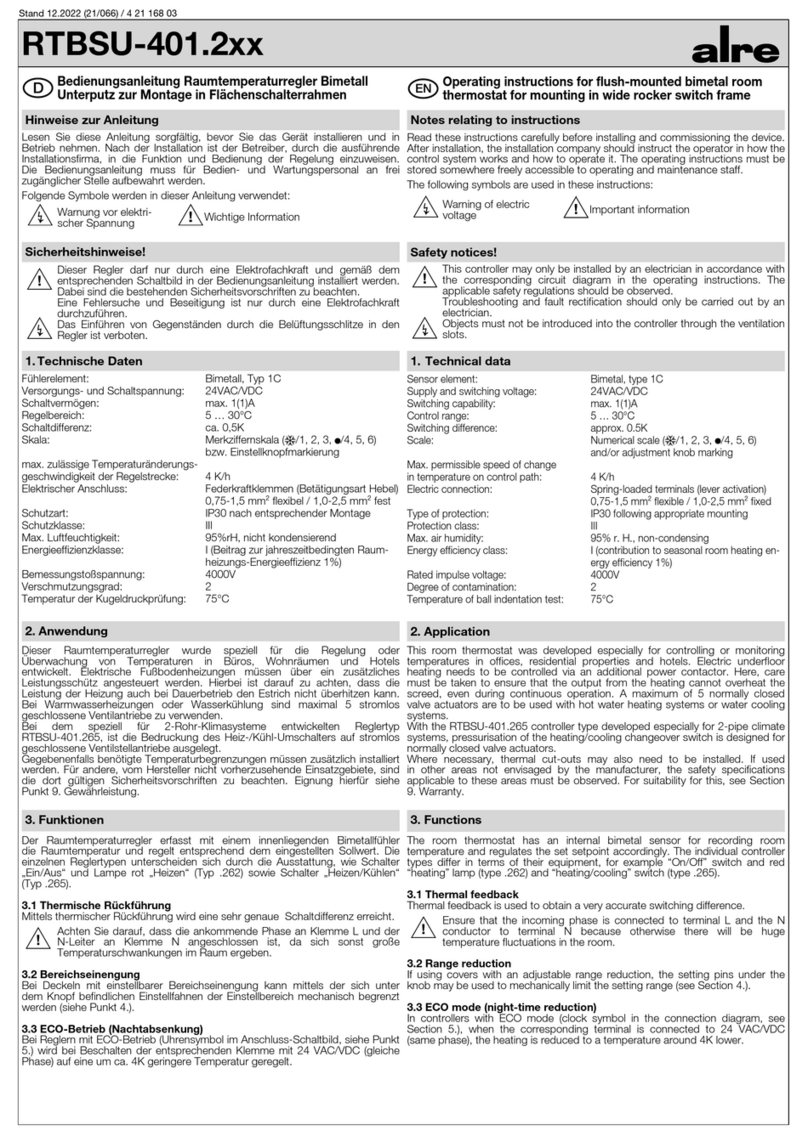
Notice d’utilisation régulateur de température ambiante bimétal
encastrable pour montage dans cadre d’interrupteur de surface
Consignes de sécurité!
2. Application
Ce régulateur de température ambiante a été spécialement développé pour
réguler ou surveiller les températures dans des bureaux, des pièces d’habitation
et des hôtels et convient particulièrement aux appareils de chauffage électriques
de forte puissance.
Avec des chauffages au sol électriques, il convient de veiller à ce que la
puissance du chauffage n'occasionne pas une surchauffe de la chape même en
mode de fonctionnement continu.
Des limitations de température nécessaires doivent être installées en supplément
le cas échéant. Pour les autres domaines d’application non prévus par le
fabricant, les directives de sécurité applicables sur site doivent être respectées.
Pour la conformité, voir au point9. Garantie.
3. Fonctions
Le régulateur de température ambiante détecte à l’aide d’une sonde interne
bimétal la température ambiante et régule en conséquence la valeur de consigne
réglée.
3.1 Retour thermique
Le retour thermique permet une différence de commutation très précise.
Veillez à ce que la phase entrante soit raccordée à la borne L et le
conducteur N à la borne N, faute de quoi la pièce pourrait être soumise à
de fortes variations de température. Ne raccordez pas la borne N pour
une capacité de chauffage supérieure à 1500 W!
3.2 Rétrécissement de plage
Sur les couvercles présentant un rétrécissement de plage, il est possible de
limiter mécaniquement la plage de réglage à l’aide du talon de réglage situé sous
le bouton (voir Point4.).
Remarques concernant cette notice
Veuillez lire attentivement cette notice avant d'installer et de mettre en service
l’appareil. Après l’installation, l’exploitant doit être formé au fonctionnement et
à l’utilisation de la régulation par la société installatrice. La notice d’utilisation
doit être conservée dans un endroit accessible au personnel de commande et
d’entretien.
Les symboles suivants sont utilisés dans cette notice:
Information importante
1. Caractéristiques techniques
Élément de sonde: bimétal, type1C
Tension d’alimentation et
de commutation: 230 VAC
Capacité de commutation
contact d’ouverture: 13(4)A max., max. 3000W
Plage de régulation: 5 … 30°C
Différence de commutation: env. 1K
Échelle:
échelle de chiffres repères ( 2 3 5 6)
ou marquage du bouton de réglage
Vitesse de changement de
température max.
autorisée du parcours de régulation: 4K/h
Raccordement électrique: bornes à ressort (type d’actionnement
à levier)
0,75-1,5 mm² flexible / 1,0-2,5 mm² fixe
Degré de protection: IP30 après montage correspondant
Classe de protection: II après montage correspondant
Humidité de l’air max.: 95% rH, non condensant
Classe d’efficacité énergétique: I (contribution à l’efficacité énergétique
du chauffage ambiant saisonnier 1%)
Surtension transitoire de mesure: 4000V
Degré d’encrassement: 2
Température de l’essai de billage: 75°C
Ce régulateur doit être installé uniquement par un électricien qualifié et
conformément au schéma de raccordement correspondant figurant dans
la notice d’utilisation. Les consignes de sécurité en vigueur doivent être
respectées.
La recherche d’erreur et les réparations doivent être entreprises
uniquement par un électricien qualifié.
Il est interdit d’introduire des objets dans le régulateur par les fentes
d’aération.
Istruzioni per l’uso del termostato per la regolazione della temperatura ambien-
te bimetallico sottotraccia per montaggio in telaio per interruttore a pulsante
Avvertenze di sicurezza!
2. Utilizzo
Questo termostato per la regolazione della temperatura ambiente è stato
appositamente sviluppato per regolare o monitorare la temperatura di uffici,
spazi abitativi e hotel ed è particolarmente adatto per riscaldatori elettrici ad alta
potenza.
In presenza di riscaldamento elettrico a pavimento, occorre verificare che la
potenza del riscaldamento non possa surriscaldare il massetto anche in caso di
funzionamento continuo.
Limitatori di temperatura eventualmente necessari devono essere installati
a parte. Per altri campi di impiego non prevedibili da parte del produttore,
rispettare le prescrizioni di sicurezza applicabili. Per la relativa idoneità vedere il
punto 9. Garanzia
3. Funzioni
Il termostato per la regolazione della temperatura ambiente rileva la temperatura
ambiente con un sensore bimetallico interno e regola di conseguenza il valore
nominale impostato.
3.1 Retroazione termica
La retroazione termica consente di raggiungere un intervallo differenziale molto
preciso.
Verificare che la fase in entrata sia collegata al morsetto L e il conduttore
N al morsetto N, poiché altrimenti nell'ambiente si verificheranno grandi
oscillazioni di temperatura. Dalla capacità di riscaldamento superiore a
1500 W, non collegare il terminale N!
3.2 Limitazione del range
Nei coperchi con limitazione del range regolabile, le apposite linguette al di sotto
della manopola consentono di limitare meccanicamente il range di regolazione
(vedere punto 4.).
Avvertenze sulle presenti istruzioni
Leggere attentamente le presenti istruzioni prima di installare o mettere in
funzione il dispositivo. La ditta che ha eseguito l’installazione deve illustrare
all’utente come utilizzare il dispositivo di regolazione e le sue funzioni. Le
istruzioni per l’uso devono essere conservate in un luogo accessibile per poter
essere consultate da utenti e personale di manutenzione.
Nelle presenti istruzioni vengono utilizzati i seguenti simboli:
Avvertenza di tensione
elettrica
1. Dati tecnici
Elemento sensore: Bimetallico, tipo 1C
Tensione di alimentazione
e commutazione: 230 V CA
Potere di interruzione contatto
di apertura: max. 13(4) A, max. 3000W
Range di regolazione: 5 … 30°C
Intervallo differenziale: ca. 1 K
Scala: Scala a più cifre ( 2 3 5 6)
o marcatura manopola di regolazione
Velocità di variazione della
temperatura massima ammessa
del percorso di regolazione: 4 K/h
Collegamento elettrico: Morsetti a innesto (tipo di aziona-
mento leva)
0,75-1,5 mm² flessibili / 1,0-2,5 mm² fissi
Tipo di protezione: IP30 con montaggio corretto
Classe di protezione: II con montaggio corretto
Umidità dell’aria max: 95% rH, senza condensazione
Classe di efficienza energetica: I (contributo all’efficienza energe-
tica stagionale del riscaldamento
d’ambiente 1%)
Tensione impulsiva di
dimensionamento: 4000 V
Grado di contaminazione: 2
Temperatura prova di durezza Brinell: 75°C
Il presente dispositivo di regolazione può essere installato solo da un
elettricista qualificato e conformemente al relativo schema elettrico
riportato nelle istruzioni per l’uso. A tale scopo devono essere rispettate
le norme di sicurezza vigenti.
Ricerca ed eliminazione guasti possono essere effettuate solo da un
elettricista qualificato.
È vietato introdurre oggetti nella fessura di ventilazione del dispositivo di
regolzione.
Informazione importante
Avertissement de tension
électrique
F IT
